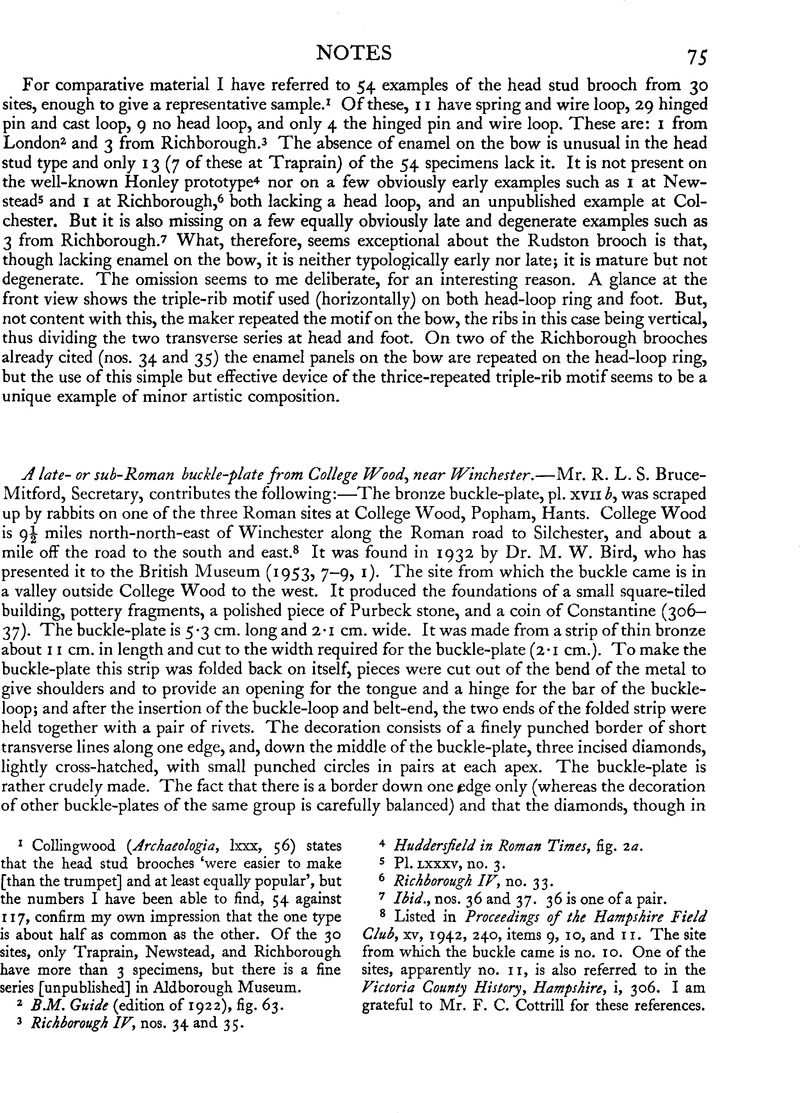Article contents
A late- or sub-Roman buckle-plate from College Wood, near Winchester
Published online by Cambridge University Press: 29 November 2011
Abstract

- Type
- Notes
- Information
- Copyright
- Copyright © The Society of Antiquaries of London 1964
References
page 75 note 8 Listed in Proceedings of the Hampshire Field Club, xv, 1942, 240, items 9, 10, and 11. The site from which the buckle came is no. 10. One of the sites, apparently no. 11, is also referred to in the Victoria County History, Hampshire, i, 306. I am grateful to Mr. F. C. Cottrill for these references.
page 76 note 1 Leeds, E. T., Archaeology of the Anglo-Saxon Settlements, fig. 8Google Scholar; Brown, Baldwin, Arts, iv, pl. CLII, no. 11Google Scholar.
page 76 note 2 British Museum, Guide to Anglo-Saxon Antiquities, 1923, fig. 108Google Scholar; Antiq. Journ., xi, 128; Leeds, E. T., Early Anglo-Saxon Art and Archaeology, fig. 6Google Scholar.
page 76 note 3 Brown, Baldwin, Arts, iii, pl. LXX, no. 6Google Scholar; Leeds, E. T., Early Anglo-Saxon Art and Archaeology, pl. XIIGoogle Scholar.
page 76 note 4 Tonnochy, A. B. and Hawkes, C. F. C., ‘The Sacred Tree Motive on a Roman Bronze from Essex’, Antiq. Journ., xi, 123–8Google Scholar.
page 76 note 5 Cf. Leeds, E. T., Early Anglo-Saxon Art and Archaeology, pl. v and pp. 4–5Google Scholar.
page 76 note 6 Dr. K. M. Kenyon, Society of Antiquaries Research Reports No. XV, 1948, 255, fig. 84, no. 14. I am grateful to Mr. J. W. Brailsford for drawing my attention to this piece.
page 76 note 7 Saxon Settlements, 56.
page 76 note 8 Forssander, J. E., ‘Provinzialromisches und Germanisches’, Meddelanden, fran Lunds Universitets Historiska Museum, vii, 1936–1937, 11–100Google Scholar.
page 76 note 9 Anglo-Saxons in England, 13 (andfig.12).
page 76 note 10 Ibid., fig. 13.
- 1
- Cited by


